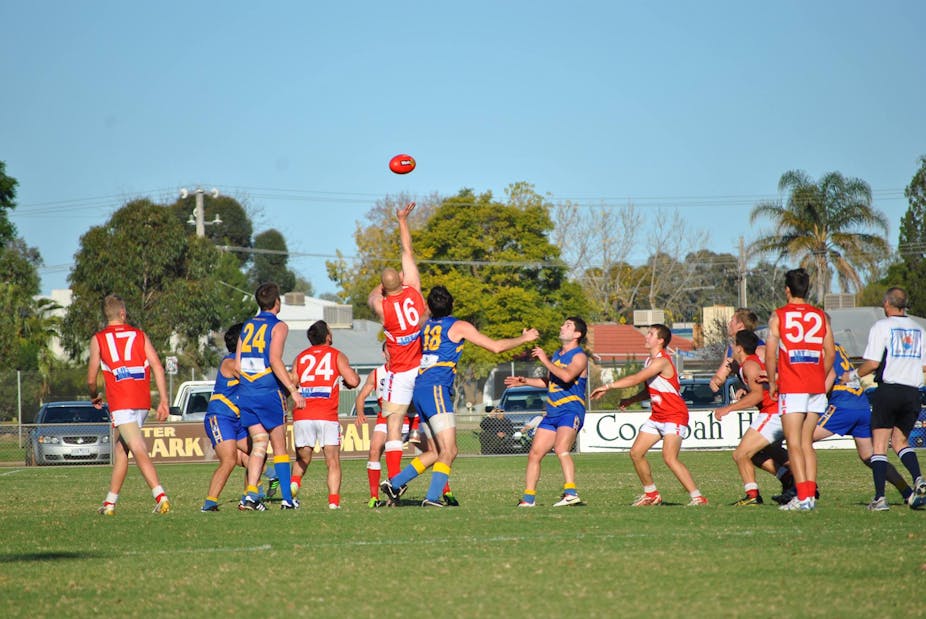Standing in the social rooms of Robinvale Football Netball Club on presentation night is perhaps like standing in any sports club in regional Australia when their vote count is on. There are the usual signs of the club’s history: trophy cabinets of past glories and photographs of past players lining the wall. The names of sponsors from around town, the special corner near the bar with a plaque commemorating a long-time club identity or past champion who has passed away. The canteen does a roaring trade in burgers as the smoke from the barbecue outside indicates that no one inside will go home hungry.
But what sets Robinvale apart is its diversity. Looking around the social rooms of the club, it’s obvious that cultural diversity is not just some concept or buzzword used by policy makers in Melbourne or Canberra.
Diversity is standing next to you at the bar. Diversity is serving you a burger. Diversity is coaching your son or daughter. Diversity is winning your best and fairest award on vote count night.
Everyday multiculturalism is alive and well in Robinvale and has been for some time.
Residents come from everywhere
It does not take much for the cultural diversity of Robinvale to hit you. Driving down the tiny main drag, Perrin Street, one is struck by the variety of people from culturally diverse backgrounds. Robinvale for many is seen as the multicultural epicentre of the Sunraysia district, stretching across the border of north-western Victoria and into south-western New South Wales. But how does that compare to the rest of Australia?
Within its local population of nearly 4,000, just under 50 different nationalities are represented. This includes Vietnamese, Malaysian, Greek, Italian, Chinese, Thai, New Zealander, not to mention the massive and highly diverse Pacific Island community, including Tongan, Samoan, Fijian and so on.
Nearly 40% of Robinvale’s population was born overseas. This might not seem to be such a notable statistic until it is compared with the region’s biggest city, Mildura. With a population of 30,000, Mildura has only half that number not born in Australia.
It is the type of work that is undertaken around the Robinvale hinterland that has drawn people here. Grapes, olives, fruit: these intensive horticultural industries need specialised human husbandry to succeed. As public debate about the value of immigrants to Australian society continues, Robinvale has prospered on the labour of new Australians.
But sport and sporting clubs are the genuine barometer of how a town is faring. It is those towns without sports teams that struggle and can quickly become ghost towns once the team ceases to be. For Robinvale it would seem that its football and netball club is successful. It is a genuine multicultural melting pot in the bush, one from which metropolitan debates and initiatives could learn a few things.

Club secretary and unofficial elder-in-residence Marion Leslie has seen many things come and go in Robinvale. The one constant has been her love of the Robinvale football club and what it represents to the town. But Leslie laments that the AFL has not engaged with the staunch football community for some time whereas rugby is establishing a beachhead and spending a great deal of money to offer the town’s Pacific Island communities a viable alternative sport, which already runs in their blood.
A sporting force for harmony
Everyday multiculturalism in Robinvale has its challenges, too. Cultural diversity has at times led to divisions within the community, never more so than when local resident Suli Ikafunga was assaulted five years ago.
The football club played a lead role in bringing disparate community groups together to ensure such violence would never happen again. The club staged a Harmony Match featuring Pacific Islander and Indigenous players in a bid to promote respect for difference. The Harmony Match is now a recognised feature on the annual sporting calendar.
The club is also a pioneer in the inclusion and celebration of Indigenous players and their families. That’s no surprise, perhaps, as Robinvale has the highest proportion of Indigenous people in Victoria, at nearly 18% of the local population.
In 2009, the club introduced an Indigenous Round, played against local rivals Wentworth, a primer in the Sunraysia league and a first outside the AFL.
A special Indigenous jumper, designed by local Koori artist Barbara Egan, is worn by all players during the annual round, instilling immense pride among both Indigenous and non-Indigenous community members. Robinvale football president Tony Calarco says of the initiative:
I got a fair buzz out of it and I don’t normally get excited about those things. I felt good about it because I was not doing it just for the hell of it. It had merit and was not a token gesture.
All of these efforts have been initiated “from below”, by individuals and community groups who voluntarily dedicate their precious time to make a difference. This is the way local residents have always done things, with little direction and support from outside sporting or government agencies.
Their current efforts are also focused on engaging Robinvale’s diverse Asian communities. While some migrants from Asia have briefly played football or netball in Robinvale, locals recognise that this is an ongoing challenge due to the transient and mobile nature of this group, whose movements are dictated by the seasonal labour patterns of the fruit industry.
For concrete examples of a diverse community coming together through sport, one need not look any further. While the spotlight of multicultural sport has been focused on the culturally diverse suburbs of Melbourne and Sydney, this regional club’s achievements in forging community relations deserve greater attention and recognition from the metropolis. Everyday multiculturalism is being lived right here, in Robinvale, on the oval.

